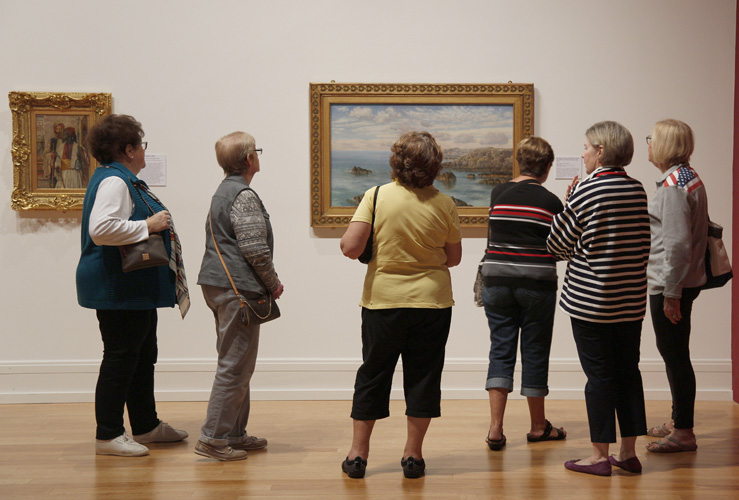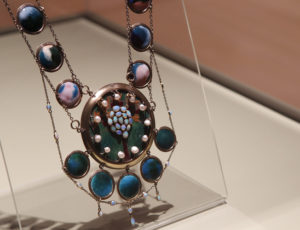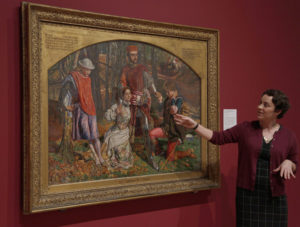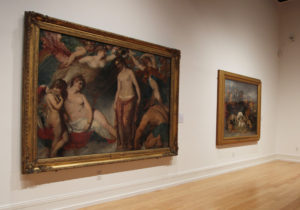
An exhibition that fills all four galleries at the Vero Beach Museum of Art with glittering displays of paintings, drawings, book art, jewelry, ceramics, metalwork and textile art is large enough that you can’t appreciate it all in one visit. “Victorian Radicals: From the Pre-Raphaelites to the Arts and Crafts Movement” contains 144 objects, each of which has the power to fascinate. To give the show its due, you will want to visit the exhibit more than once before the show closes on May 5.

The Christabel Necklace designed by Silversmith, George James Frampton, displayed at the Vero Beach Museum of Art. [Kaila Jones/32963][Kaila Jones/32963]
“This is the first exhibition in the museum’s history to occupy all four of the museum’s galleries: the Holmes, Titelman, Schumann and Stark, plus the Stark Rotunda,” says Danielle Johnson, VBMA curator of modern and contemporary art.
Johnson’s work with Victorian Radicals included selecting, in concert with Matthew Mangold, VBMA chief preparator, paint colors for the gallery walls to set off the objects on display. In the Holmes Gallery, wine-red accent walls reflect mid-19th century England’s taste for deep hues and detailed ornamentation. The earliest Pre-Raphaelite paintings, as well as craft objects from London’s Great Exposition of 1851, are located here.
For the normally antiseptic white transition area between the Holmes, Titelman and Schumann Galleries, Johnson selected a perennially chic Morris and Company acanthus wallpaper to put the visitor in the mood for the second-generation Pre-Raphaelite paintings and Arts and Crafts objects in the latter two galleries.

Danielle Johnson curator of Modern and Contemporary Art at Vero Beach Museum of Art. [Kaila Jones/32963]
At the main entrance to the exhibition, the first artwork in the Holmes Gallery represents an English painting in the decades preceding the advent, in 1848, of the artists who called themselves Pre-Raphaelites. It is Charles Lock Eastlake’s “The Champion” of 1824, depicting a medieval knight accepting a challenge from a turbaned messenger at left. Between them, in the distance, the knight’s mounted rival raises his sword to signal, “Here I am!” At the knight’s left, a fair maiden ties a pink sash around the hero’s breastplate, as a grave monk looks on.
A Royal Academician and a director of London’s National Gallery, Eastlake “was definitively part of the establishment,” says Johnson.
Eastlake populated “The Challenge” with type-cast characters that go back to the ideals of the Italian Renaissance, which in turn found inspiration for the human form in classical Greek and Roman statuary. “The Challenge,” therefore, gives us the expected European hero of aquiline nose, lowering brow and cheekbones to die for; a blond maiden who could double for the Virgin Mary; a middle-aged man, gray of beard but hale of body; and a dark-skinned male in the role of exotic “other.”

Pandora Crowned by the Seasons by William Etty displayed at the Vero Beach Museum of Art. [Kaila Jones/32963][Kaila Jones/32963]
In reaction to this type of art, a Pre-Raphaelite Brotherhood was founded in 1848 by artists William Holman Hunt, John Everett Millais and Dante Gabriel Rossetti. They sought to give their paintings modernity by looking back to a time in art before the humanistic values and art forms of the Renaissance spread throughout Europe.
For the Pre-Raphaelites, the art of the Italian painter Raphael, born Raffaello Sanzio da Urbino in 1483, exemplified the Renaissance. The softly rounded forms, subtle color and gracefulness of Raphael’s figures – indeed, his suppression of anything that could be considered inharmonious within the picture – soon became the academic model for generations of art students, well into the 19th century.
Raphael’s example also summed up exactly what the Pre-Raphaelites abhorred. Theirs was not to be an art of bland harmony, or truisms masquerading as truth. They wanted to show life as they knew it — in all its complicated abundance and prismatic color. No detail was too small, or too profuse, to be excluded from their pictures. Their inspiration was the culture of medieval northern Europe, with its rich history of textile design, stained glass and illuminated manuscripts.
“The Pre-Raphaelite Brotherhood was cohesive and worked closely with one another, for only about five years,” says Johnson.
But the styles and ideas they developed during that time were carried forward not only by their own cohort, but also by succeeding generations of English painters for the next 50 years, as exemplified by objects throughout the exhibition.
To illustrate the difference between the old style and the new, Johnson points to an 1851 painting by William Holman Hunt, “Two Gentlemen of Verona,” that depicts a scene from Shakespeare’s comedy.
It shows the moment when, at center stage, the knight Valentine rescues his girlfriend Sylvia from the amorous advances of his friend Proteus. Disguised as a boy, Proteus’ true love, Julia, has seen everything – and leans sulking against a tree. Evidently, Proteus is as changeable as the shape-shifting sea god he is named after.
“You are immediately struck by how bright the colors are that Hunt used,” says Johnson, remarking on the purple and flame-red of Julia’s garments, and the pink pants (hot in more ways than one) of Proteus.
Also remarkable are the naturalistic poses of the characters. Take Proteus, who is seen on awkwardly bended knee. He holds his left hand to the back of his neck, as though to signify the place where Valentine grabbed him (impudent pup!) away from Sylvia. Proteus’ right hand is clasped in Valentine’s left. It is uncertain whether Valentine is giving him a hand up, or forcing him to remain kneeling before Sylvia in apology.
Sylvia’s reddish hair bespeaks Celtic ancestry; her slightly bulging eyes suggest myopia. Her pallor does not do for a spirited Italian girl; Shakespeare’s Sylvia was the Duke of Milan’s courageous daughter, determined to risk all for her Valentine. Hunt’s Sylvia is neither the ideal of the ancients, nor of the Renaissance. More hothouse lily than Lombardy sunflower, this Sylvia is an Englishwoman.
You can spend much of your time in the show reading the story every painting has to tell.
There are plenty of high-minded subjects from literature, the Bible and Greek mythology, but the pleasures and ills of life in Victorian England are also represented.



